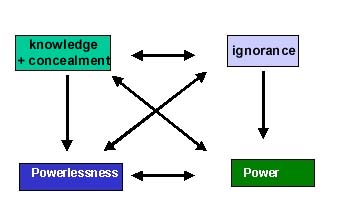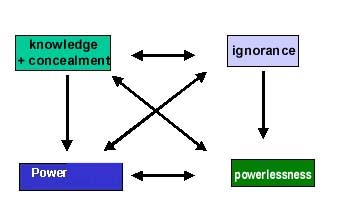|
|
Foucaultian Reading |
|
Lacan's interpretation |
|
Paradoxes:
| 1. before the story begins:
The Queen (in Powerlessness) conceals
her affair from the King (power) so that the King's authority is
not threatened.
 |
2. This delicate balance is broken
by Minister D. at the beginning of the story:
Minister D's Concealment of the letter and his Disclosure to the Queen of the fact of his holding the letter. The Queen is under Minister D's power because she knows (as shown by the Minister) that he holds and hides the letter.  |
||
3. Interestingly, in the middle part, the Prefect is the one with knowledge
but without power; the one who reveals without knowing what he reveals
(which he calls "odd"). And then as Dupin starts his reasoning, he
is the one to hold the knowledge and hide it from the Prefect.
 |
4. At the end, after the letter is
retrieved, the Queen's double concealment (of the letter and of her holding
the letter) puts her in the position of power.
|
||
| 5. The final revelation is that Dupin (with knowledge and concealment/unconcealment) has Minister D (ignorance and disclosure) as an object of revenge. | --> Against traditional detective fiction, where unconcealment and knowledge leads to power, the story does not focus on disclosing "whodunit," but shows a continuous interaction between and reversal of power/powerlessness. (There are different kinds of knowing and ignorance, mixture of concealment and unconcealment.) |
Foucaultian
Reading (source: Hull, Richard. "'The Purloined Letter': Poe's
detective story vs. panoptic Foucauldian theory. Narration vs. Policing Power."
Style, Summer90, Vol. 24 Issue 2, p201, 14p.)
1. Penoptic critics: narration as a kind of penoticism. (writing as a way of "objectification and subjection.") "For panoptic Foucauldians such as Miller and Mark Seltzer, narration is the police."
2. However, "The Purloined Letter" presents a detective who is against surveillance and protective of the Queen's secrecy.
3. "Like Poe's story, the Foucault of counter-discourse offers hope that the growth of panoptic discipline is not "ineluctable."[3] This early Foucault would have been interested in the counter-discursive tactics of "The Purloined Letter," which expose the weak sides of panoptic surveillance, and suggest a need to narrow the range of panoptic Foucauldian theory. Poe consciously writes counter-discourse, and escapes the Panopticon, even as he founds the detective-story genre. "
Psychobiography: Marie Bonaparte ( 130 Muller, et al.)
1. It "express[es] . . . .regret for the missing maternal penis, with reproach for its loss."
2. the letter, "very symbol of the maternal penis, also 'hangs' over the fireplace, in the same manner as the female penis, if it existed, would be hung over the cloaca which is here represented ...by the general symbol of fireplace or chimney."
3. Minister --John Allan and Poe; the King --David Poe, Elizabeth's husband; Dupin--Poe.
|
|
Scene 2 | Scene 3 | |
|
1. [the blind]: sees nothing and thus is blind
to the situation;
|
The King | The Queen | The Minister |
| 2. [the complacent seer]: sees that the first subject sees nothing . . . is unaware of being seen; | The Queen | The Minister | Dupin |
| 3. [the robber]: sees that the first two leave what should be hidden exposed. . . | The Minister | Dupin | Lacan |
* A correlation between the real and the first position, the imagniary and the second position and the symbolic and the third position.
* "What correlated the third position with the symbolic is the fact that it
discerns the role of structure in the situation and acts accordingly.
The paradox is that, . . . the "acting accordingly" of the third position tends
to catch the subject up in the dynamics of repetition that drag him into the
second position. . . (63 Muller, et al.)
1. For Lacan (according to Derrida), "the subject is very divided, but
the phallus is not to be cut"(196);
The letter
-- should not be 'truth' or present: it never truly arrives; when it does arrive
its capacity not to arrive torments it with an internal drifting.
-- should be divided, but not unified
[According to Barbara Johnson]-->
Summary
of the article
1. What Lacan puts into the letter:
While asserting that the letter's meaning is lacking, Lacan, according to Derrida, makes this lack into the meaning of the letter. . . .Derrida asserts that what Lacan means by that lack is the truth of lack-as-castration-as-truth.2. What Lacan leaves out of the text.
Lacan ignores the story's position in "Dupin Trilogy."